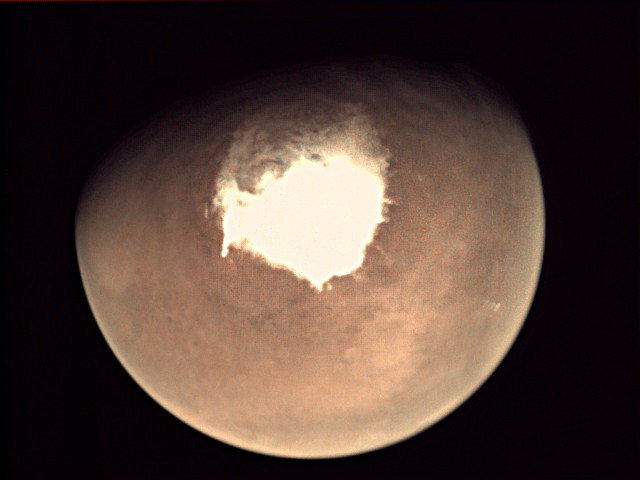Popular Reads
Top Results
Can't find what you're looking for?
View all search resultsPopular Reads
Top Results
Can't find what you're looking for?
View all search resultsMars weather: 'Cloudy, chance of nighttime snowstorm'
Change text size
Gift Premium Articles
to Anyone
M
ars is buffeted by turbulent snowstorms that occur only at night, according to a study released Monday that revises our understanding of Red Planet weather.
Up to now, it was thought that snow falling from low-lying Martian clouds settled slowly and sparsely to the ground in a environment bereft of violent winds.
The new findings, reported in the journal Nature Geoscience, suggest that ice-water particles swirling in a storm hit the ground within minutes, rather than descending gently for hours.
But future colonists from Earth needn't bother packing snow shoes, the lead researcher told AFP.
"It's not as if you could make a snowman or ski," said Aymeric Spiga, an expert on the dynamics of planetary atmospheres at Universite Pierre Curie in Paris.
"Standing on the surface of Mars you wouldn't see a thick blanket of snow -- more like a generous layer of frost."
The atmosphere of Mars is 100 times thinner than Earth's, though still thick enough to support weather, including clouds and wind.
But there's very little moisture. Indeed, the Red Planet is essentially a bone-cold desert with virtually no liquid water on its surface.
In the Martian arctic, however, water ice lurks just under a layer of dust.
This was detected up close by NASA's Phoenix lander, which scraped below the planet's surface with a shovel in 2008.
Read also: Mars surface 'more uninhabitable' than thought: Study
The stationary robot lab also analysed local weather, detecting signs of precipitation below water-ice clouds. A pair of orbiting satellites also picked up clues suggesting night-time weather, especially over the northern polar region.
Both observations perplexed scientists at the time.
To probe further, Spiga and colleagues devised a new atmospheric model to simulate weather on Mars, based on more fine-grained data.
Cooling of water-ice cloud particles during the cold Martian night, they found, can create unstable conditions in clouds.
"We have shown that the precipitation of snow below the clouds is transported by very violent, descending winds," said Spiga.
He compared these Martian snowstorms to small, localised weather phenomena on Earth called microbursts, in which cold, dense air carrying snow or rain descend rapidly from a cloud.
The simulations were a better fit with the satellite and lander observations, he added.
The Martian atmosphere is 95 percent carbon dioxide (also present as frozen dry ice), along with two percent each argon and nitrogen, with trace amounts of oxygen, nitrogen oxide, neon, and krypton.
A whispy atmosphere and its greater distance from the sun make Mars very cold, with an average temperature of minus 63 degrees Celsius (minus 81 degrees Fahrenheit). Earth, by comparison, is a balmy 16 C (61 F).











